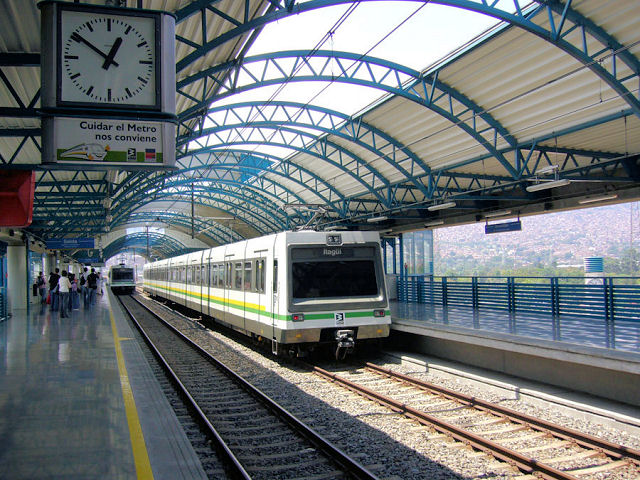 Medellín Metro station [Photo: HK4ECG]
The Light Rail Now Project can be contacted at: Light Rail Now! |
At present the only rail transit system serving any Colombian city, Medellín's Metro (rail rapid transit) currently consists of 28.8 km (17.9 miles) of route on two lines crossing the Medellín metropolitan area from north to south (Line A) and from east of the city center to the west (Line B). The system has a total of 25 stations – 19 on Line A and 6 on Line B (with one for interconnection between the two lines) In addition, two aerial cableways, designated Lines J and K, feed the Metro.
In the map below, Line A is shown in dark blue, and Line B is shown in ochre/orange.
The connecting cableways are shown in yellow and green.
Medellín's Metro was completed in 1996 after sixteen years of planning and construction by Colombian, German, and Spanish companies at a cost of US$1.9 billion. Construction of the Metro commenced In 1984, as a municipal project, and 11 years later, on 30 November 1995, the Metro began its first operation on an elevated section of Line A between Poblado and Niquia stations. Full operation began in 1996. According to Wikipedia (25 August 2009), daily ridership totaled 400,000 as of 2007. Trains run daily from 05:00 to 23:00, arriving at stations every three minutes during peak periods, and every 10 minutes otherwise. Several trains also operate during morning and evening rush hours directly from Niquía to San Javier via a connecting track linking the Caribe station on Line A and the Suramericana station on Line B. Medellín's Metro serves approximately 150,000 residents of communes (neighborhoods) 1 and 2, and indirectly 350,000 residents of the northeastern area where many workingclass people live.
In addition, recounts Medellín Traveler, the Metro "has also created many public and cultural spaces along its lines: squares, restaurants, parks, recreational places, cultural areas, business sites, giving a new vision to the second largest Colombian city." The website also provides some descriptive details of the two Metro lines:
According to the Wikipedia article, soon after the inauguration of the Metro,
In addition, the Metro has pulled the disparate neighborhoods of the city closer together:
Information for this Fact Page has been adapted from narratives in the following
sources:
Light Rail Now! website | ||
|
|
|||